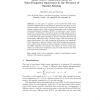132 search results - page 3 / 27 » Linear State-Space Models for Blind Source Separation |
ICA
2010
Springer
13 years 6 months ago
2010
Springer
In this paper, we propose a novel method for blind source separation (BSS) based on time-frequency sparseness (TF) that can estimate the number of sources and time-frequency masks,...
ICA
2004
Springer
13 years 10 months ago
2004
Springer
SOBI is a blind source separation algorithm based on time decorrelation. It uses multiple time autocovariance matrices, and performs joint diagonalization thus being more robust th...
TNN
2008
13 years 4 months ago
2008
Blind inversion of a linear and instantaneous mixture of source signals is a problem often encountered in many signal processing applications. Efficient FastICA (EFICA) offers an ...
TASLP
2002
13 years 4 months ago
2002
Convolutive blind source separation and adaptive beamforming have a similar goal--extracting a source of interest (or multiple sources) while reducing undesired interferences. A be...
CSDA
2007
13 years 4 months ago
2007
In blind source separation, there are M sources that produce sounds independently and continuously over time. These sounds are then recorded by m receivers. The sound recorded by ...

